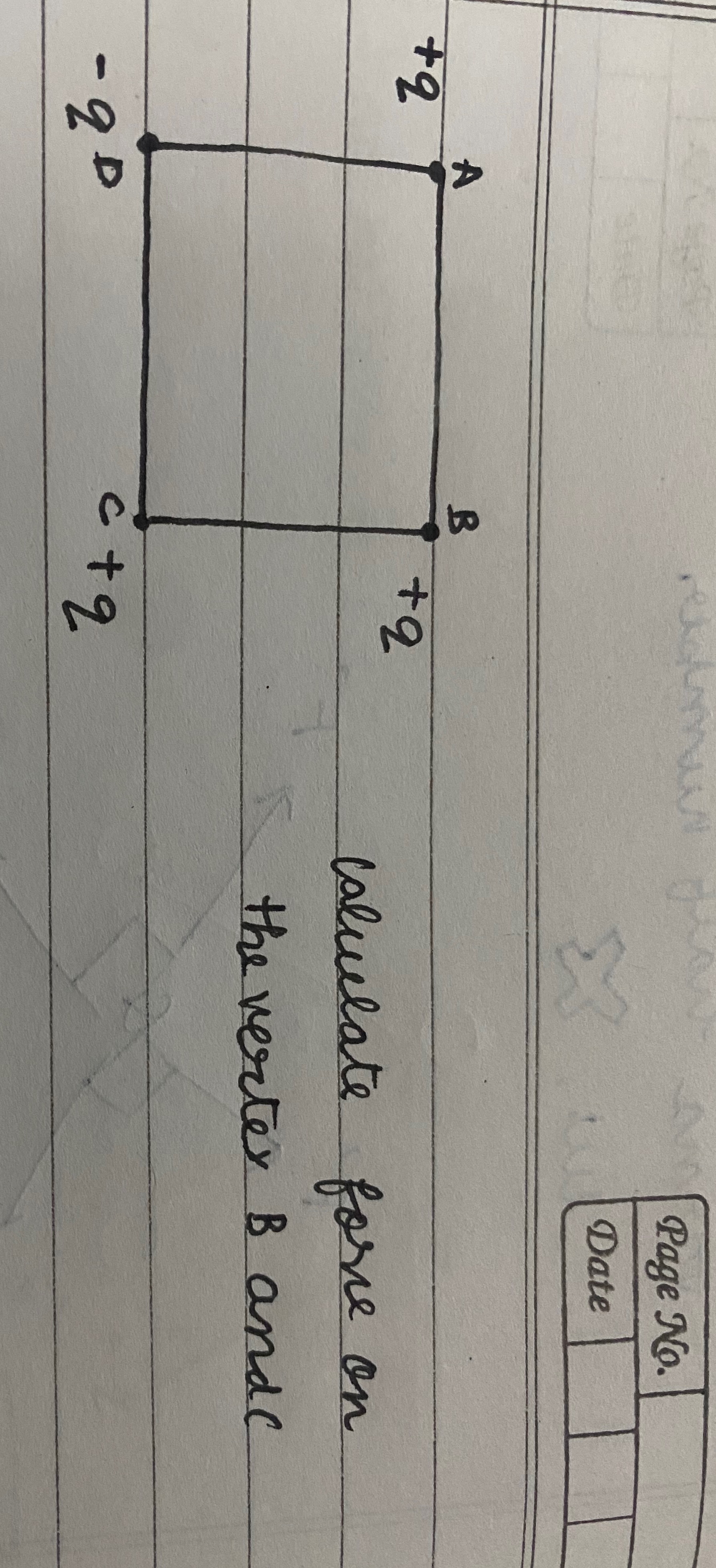Question
Question: calculate force on the vertex B andc...
calculate force on the vertex B andc

Force on vertex B:
FB=a2k[(4−22q)i^+(22q−2q)j^]Force on vertex C:
FC=a2k[(2q−2q2)i^+(2q+2q)j^]Solution
We choose a square of side length a with vertices
A = (0, 0), B = (a, 0), C = (a, a) and D = (0, a).
The charges are
A: +2, B: +2, C: +q, D: –2q.
All forces are calculated by Coulomb’s law
F = k·(q₁q₂)/r²
and the direction (attraction or repulsion) is decided by the signs of the charges.
Step 1. Force on B
The net force on charge at B (q_B = +2) is the vector sum of the forces due to A, C and D.
-
Force due to A (charge +2 at (0,0)):
- Separation: AB = a.
- Magnitude: F_BA = k · (2×2)/a² = (4k)/a².
- Direction: Since both charges are positive the force is repulsive; B is repelled away from A. The vector from A to B is (a, 0) so
F_BA = (4k/a²) î.
-
Force due to C (charge +q at (a,a)):
- Separation: BC = a.
- Magnitude: F_BC = k · (2×q)/a² = (2kq)/a².
- Since both are positive, the force is repulsive. The line joining B to C is vertical (from B = (a,0) to C = (a,a)); so B is repelled in the opposite direction of C, i.e. downward.
F_BC = (2kq/a²)(–ĵ).
-
Force due to D (charge –2q at (0,a)):
- Separation: Distance from B = (a,0) to D = (0,a) is r = √(a²+a²)= a√2.
- Magnitude: F_BD = k · |2×(–2q)|/(a√2)² = k · (4q)/(2a²) = (2kq)/a².
- B is positive and D is negative so the force is attractive. The vector from B to D is D – B = (0–a, a–0) = (–a, a). Its unit vector is
u = (–a, a)/(a√2) = (–1/√2, 1/√2).
Thus, F_BD = (2kq/a²)(–1/√2 î + 1/√2 ĵ).
Now summing all contributions (using î, ĵ for the unit vectors in x and y directions):
-
x‐component:
F_B,x = (4k/a²) + (–2kq/(a²√2))
-
y‐component:
F_B,y = (–2kq/a²) + (2kq/(a²√2))
Thus,
FB=a2k[(4−22q)i^+(22q−2q)j^].Step 2. Force on C
Now the charge at C is +q. Its force arises from charges at A (+2), B (+2) and D (–2q).
-
Force due to A (at (0,0)):
- Separation: from A to C is along the diagonal: AC = a√2.
- Magnitude: F_CA = k · (q×2)/(a√2)² = k·(2q)/(2a²)= kq/a².
- Direction: Since both are positive, repulsion pushes C in the direction from A to C. The vector A→C = (a, a) with unit vector (1/√2, 1/√2).
Thus, F_CA = (kq/a²)(1/√2 î + 1/√2 ĵ).
-
Force due to B (at (a,0)):
- Separation: BC = a.
- Magnitude: F_CB = k · (q×2)/a² = 2kq/a².
- Both positive so the force on C is repulsive; the line from B to C is vertical upward.
Thus, F_CB = (2kq/a²) ĵ.
-
Force due to D (at (0,a)):
- Separation: CD = a (since C = (a,a), D = (0,a)).
- Magnitude: F_CD = k · |q×(–2q)|/a² = (2kq^2)/a².
- Since C is positive and D is negative, the force is attractive. The vector from C to D is (0–a, a–a) = (–a, 0) with unit vector (–1, 0).
Thus, F_CD = –(2kq^2/a²) î.
Now summing for C:
-
x‐component:
F_C,x = (kq/(a²√2)) – (2kq^2/a²)
-
y‐component:
F_C,y = (kq/(a²√2)) + (2kq/a²)
Thus,
FC=a2k[(2q−2q2)i^+(2q+2q)j^].Summary of the Answer
- Force on vertex B:
- Force on vertex C:
Any answer that is algebraically equivalent is correct.
